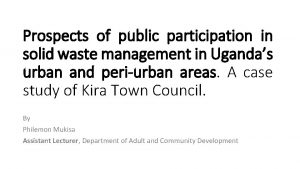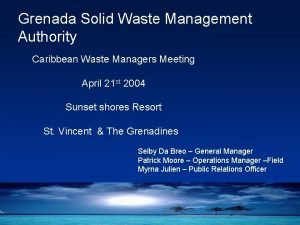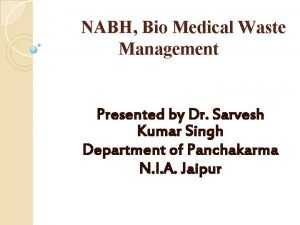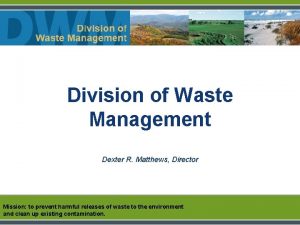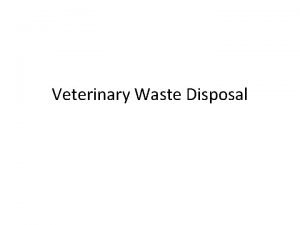Disposal of S W a Disposal on in



- Slides: 3

Disposal of S. W a. Disposal on / in the earth's mantle or, b. Disposal a the bottom of the sea or ocean (prohibited by 1933 in U. S. A). Disposal on / in the earths mantle (land disposal): The primitive methods of disposal: 1. Throwing refuse on the ground surface at random. 2. Throwing refuse on the ground in some single location beyond the confines of the community. 3. As in (2) with covering the refuse heap with inert material. 4. The most advanced method is the "sanitary L. F" which has proved to be the most economical and acceptable method sanitary and environmentally. Sanitary L. F Means the process in which the waste are compacted and covered with a layer of soil at the end of each day's operation when the disposal site has reached it's ultimate capacity a final layer of (2 ft) or more of cover material is applied (final cover). Advantage of sanitary L. F 1. Where land is available it is usually the most economical method for disposal. 2. It is a complete or final disposal method as compared to incineration and composting. 3. It can receive all types of S. W. 1

4. It is flexible process, as increased quantity of S. W can be disposed of with little additional personal or equipment. 5. Sub marginal land may be reclaimed for various uses (parking lots, play group). Disadvantage. 1. Suitable land many not be available. 2. Methane and other gar generated many be hazards. Aspects of the design and operation of sanitary L. F. 1. Factors in land fill site selection. 2. Land filling methods. 3. Gas and leachate movement and control. 4. Design of landfill. Site Selection In site selection, consideration should be given to the following variables: 1. Available land Area. 2. Public opposition. 3. Proximity of major road ways. 4. Haul distance, speed time, load limits. 5. Traffic patterns and congestion. 6. Soil condition and topography (availability of cover Material ) 7. Climatological conditions. 8. Surface water hydrology. 9. Local environmental conditions. 10. Potential ultimate uses for of the complete site. 2

11. Buffer area around the site. Find selection of site usually is based on the results of 1. A preliminary site survey. 2. Results of Eng. design and cost studies. 3. Environment al impacts assessments. 4. Additional details on site selection. Land area requirement: In selection of potential land site, it is important to assure that sufficient land (volume) area is available to operate for at least one year at a given sits. It is common to find disposal sufficient for (510) years operations. 3
